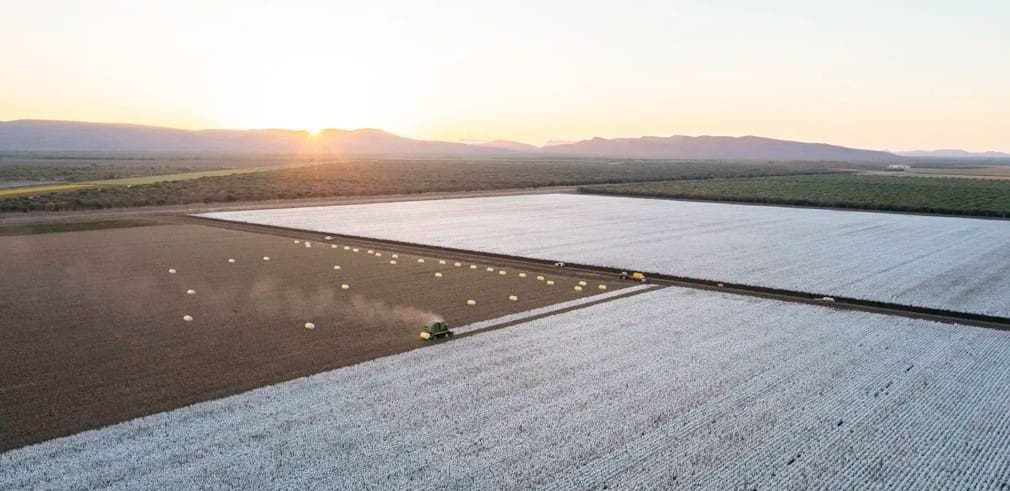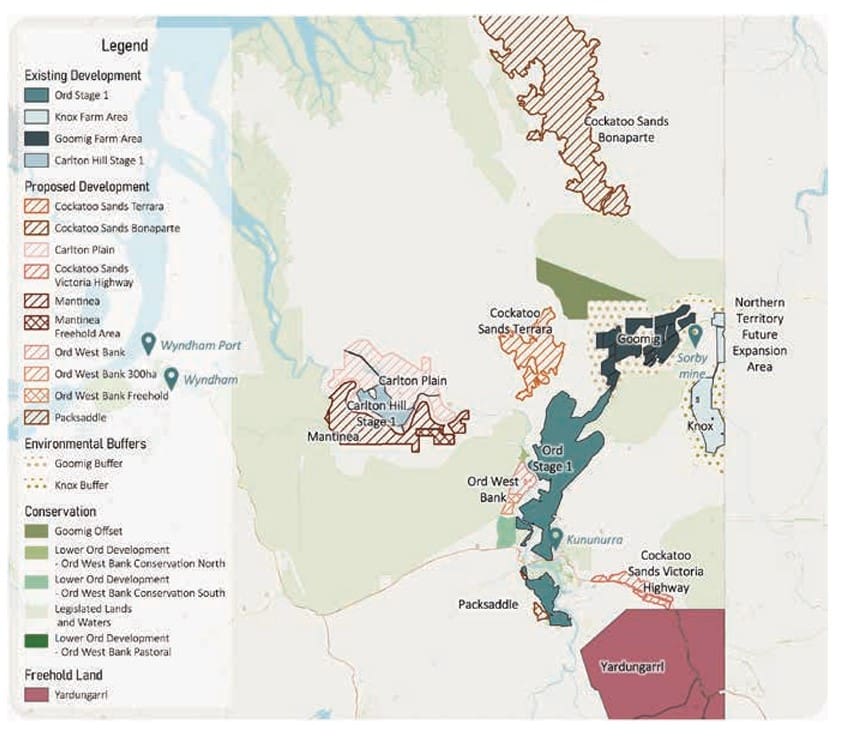
The Kimberley cotton gin development is expected to fuel further interest in growing the crop in the Ord River. Photo: NAIF
THE WESTERN Australian Government has released a 10-year strategy to guide development of the Ord River Irrigation Area (ORIA), with cotton identified as the emerging dominant crop for the region.
The strategy’s vision for 2024 to 2034 is to expand the current 28,000ha of farmland to up to 50,000ha, backed by value-add processing facilities.
Currently the ORIA produces a range of broadacre and horticulture crops, including sandalwood, maize, cotton, melon, pumpkin, mango, and other fruit and vegetables.
WA Regional Development Minister Don Punch said the plan sets the strategic direction for the ORIA with the goal of ensuring its future as a productive, self-sustaining, and environmentally responsible farming region.
“Built on a history of resilience and innovation, the Ord River Irrigation Area is on the cusp of capitalising on historic and recent investment to realise its full potential and deliver strong economic outcomes for the East Kimberley region,” Mr Punch said.
“The Cook Government will continue to work closely with industry, traditional owners, and the community to build on the region’s strengths and capitalise on new and emerging opportunities to deliver long-term benefits for the East Kimberley region.”
As part of the plan, the WA Government will support the agricultural sector and traditional owners to drive the vision through initiatives such as land and water-use planning, strategies to meet workforce needs, research and development, and empowering Aboriginal communities.
Future agricultural expansion
The existing ORIA agricultural development includes Ord Stage 1, Knox and Goomig farm areas and Carlton Hall Stage 1.
In order to almost double the ORIA farmland, the strategy identified several possible sites for future agricultural developments
These include Carlton Plains Phase 2 and Mantinea (8000ha), Ord West Bank (1700ha), Cockatoo Sands Tarrara (4000ha), Cockatoo Sands Victoria Highway (2200ha) and the Keep Plains on the Northern Territory side of the border.
The plan identified the “incremental development of these land parcels” as “key to achieving the scale of development set out in the ORIA vision”.

Existing and proposed development sites in the ORIA. Source: WA DPIRD
Cotton development
The strategy has a clear focus on cotton as an “emerging primary crop” with goals around processing and logistics centred on ensuring it has a long-term future in the north.
ABARES has predicted WA will plant 2700ha of cotton in 2024-25, a slight decrease on the previous year’s area of 3500ha.
However, the construction of the Kununurra cotton gin, due to be completed in the second half of 2025, is expected to create added confidence in the crop and increase plantings.
The strategy identified the need for additional land parcels as a primary priority for a sustainable cotton industry.
“With cotton fulfilling the primary crop function in the ORIA, the long-term sustainability of the region will rely on ensuring additional land beyond that needed to support the cotton gin is available to support growth in the broader agriculture system,” the document said.
It also highlighted the probability that “some existing land parcels within the ORIA” would transition from crops, such as sandalwood, to growing cotton.
The importance of securing the Port of Wyndham as part of the cotton supply chain was also a feature of the strategy.
“Cotton growers in the region are currently identifying the optimal path to market for the products being grown and processed in the region and have sought estimates of fees to import/export containers through the Port of Wyndham.”
Currently, first points of entry (FPOE) restrictions on Wyndham have limited the options for growers to export containers from the port.
The industry has since explored the prospects of exporting processed cotton via transporting containers to Katherine by road and then to Adelaide by rail.
The Kimberley Port Authority is currently progressing a proposal to obtain FPOE status at Wyndham which could make the port a viable option for exports.
Value-add possibilities
Alongside the cotton gin development, the strategy indicated the potential of several other value-add facilities in the Ord which would operate in tandem with the gin.
These include investigating cattle feedlot and oilseed press facilities as opportunities for the region.
The WA Department of Primary Industries and Regional Development has progressed a pre-feasibility assessment of the potential development of an oil press facility in the Kimberley.
It is envisaged that the facility could process cottonseed and potentially future seed crops such as safflower, sunflower or peanut.
The facility could provide additional local value add opportunities to the emerging cotton industry as well as support the intensification of local cattle production systems.
Alongside this work, planning is underway for a research project to establish a pilot cattle feeding facility in the East Kimberley region.
The facility would utilise a range of tropical feed rations sourced from the irrigated cropping industry, including cotton by-products and corn.
It is hoped that long-term the project will provide learnings to support “environmentally friendly intensification of northern beef production systems based on an affordable source of protein”.
Source: WA Government